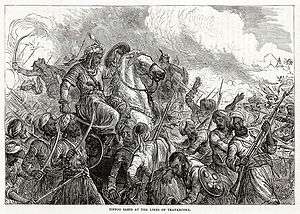Battle of the Nedumkotta
| ||||||||||||||||||||||||||
The Battle of the Nedumkotta took place on the 28 December 1789, and was a reason for the opening of hostilities in the Third Anglo-Mysore War. Forces of Tipu Sultan, the ruler of the Kingdom of Mysore, attacked the fortified line known as the Nedumkotta in Thrissur district that protected the Kingdom of Travancore, an ally of the British East India Company. Tipu Sultan made major advancements on Travancore, however, had to return to his Kingdom to prepare for a British attack.
Situation in Travancore
The strength of the Travancore Nair Army was greatly reduced after several earlier battles with Hyder Ali's forces. The death of the Dutch-born commander Valiya-kappitan Eustachius De Lannoy in 1777 further diminished the morale of the soldiers. The death of Makayiram Thirunal and Asvati Thirunal in 1786 forced the Travancore royal family to adopt two princesses from Kolathunad. As the threat of an invasion by Tipu Sultan loomed in the horizon, Travancore's maharajah Dharma Raja tried to rebuild his army by appointing Chempakaraman Pillai as the dalawa and Kesava Pillai as the sarvadhikaryakkar.[3]
Preparations for the battle
Tipu Sultan planned the invasion of Travancore for many years, and he was especially concerned with the Nedumkotta fortifications, which had prevented his father Hyder Ali from annexing the kingdom. Towards the end of 1789, Tipu Sultan marched his troops from Coimbatore. Tipu's army consisted of 20,000 infantry, 10,000 spearmen and match-lockmen, 5,000 cavalry and 20 field guns.[4]
Travancore purchased the strategic forts of Cranganore and Ayacottah from the Dutch to improve the country's defenses. The deal was finalized by Dewan Kesava Pillai and Dutch merchants David Rabbi and Ephraim Cohen under the observation of Maharajah Dharma Raja and Dutch East India Company Governor John Gerard van Anglebeck. Travancore also held a treaty with the British East India Company, under whose terms two battalions of the Company army were stationed at the Travancore-Cochin frontier. Tipu Sultan objected to these purchases because the forts, even though they had long been in Dutch hands, were in a territory that paid him tribute.
Kesava Pillai was appointed as the Commander-in-Chief of the Travancore Army. To boost the strength of the armed forces, several thousand youngsters militiamen were called up from regions all over the kingdom. The forts of Cranganore and Ayacottah were repaired and garrisoned.[5]
The battle
On 28 December 1789, Mysorean troops, not led personally by Tipu Sultan were fired upon by Travancore troops. The Mysorean troops advanced from the Travancore lines, but were eventually stopped when faced with six-pounder guns used by the Travancore troops and were repulsed.[6][7] Large number of mysorean troops were captured as prisoners and were imprisoned in undayagiri fort.The Nairs of Travancore recovered the sword, the pallanquin, the dagger, the ring and many other personal effects of Tipu Sultan from the ditches of the Nedumkotta and presented them to the ruler of Travancore. Some of them were sent to the Nawab of Carnatic on his request.After approximately 2 months after this incident, on March 1, 1790, 1,000 Travancore troops advanced onto Mysore territory, where they were stopped and pushed back with considerable losses by Mysorean troops.[8] On April 9, 1790, a similar attempt was made once again by 3,000 Travancore troops on Mysore territory, however, they were once again stopped by Mysorean troops and repulsed.[8]
On April 12, 1790, Tipu decided to attack the Travancore lines and within approximately three days was able to breach three quarters of a mile of the lines.[8] On April 15, 1790 he took approximately 6,000 soldiers and advanced on the Travancore position.[2] The Travancore troops were taken by surprise and fled.[2] On April 18, 1790, Tipu arrived within one mile of Cranganur and erected batteries.[2] On May 8, 1790, Tipu successfully occupied Cranganur.[2] Soon other forts such as Ayicotta and Parur surrendered without fighting.[2] Tipu Sultan destroyed the Travancore lines and reached all the way to Verapoly, The Travancorean forces regrouped, but the onset of monsoons prevented Tipu from moving south(combat being much more difficult during the monsoon season). He finally reached the Periyar river banks at Aluva and camped there. However, by this time a small group led by Vaikom Padmanabha Pillai and Kunjai Kutty Pillai went upstream and managed to break the walls of a dam at Bhoothathankettu causing heavy flash floods downstream Periyar river. All the ammunition and gunpowder of Tipu's army got wet and became inactive. He was thus forced to return. Information that the British army was planning an attack on Srirangapatnam hastened his retreat
Aftermath
The British seeing the rapid advance of Tipu Sultan and his forces decided to attack him as they considered him a major threat to their interests.
See also
References
- ↑ Mia Carter; Barbara Harlow, Archives of Empire: Volume I. From The East India Company to the Suez Canal, p. 174
- 1 2 3 4 5 6 Hassan (2005), p. 167
- ↑ The Travancore State Manual by V Nagam Aiya, Vol.1, Page 385
- ↑ The Travancore State Manual by V Nagam Aiya, Vol.1, Page 390
- ↑ The Travancore State Manual by V Nagam Aiya, Vol.1, Page 393
- ↑ Mohibbul Hasan (2005), History of Tipu Sultan, Aakar Books, p. 164
- ↑ John Clark Marshman, The history of India, p. 450
- 1 2 3 Hassan (2005), p.166
Sources
- Fortescue, John William (1902). A history of the British army, Volume 3. Macmillan.
- Marshman, John Clark (1863). The history of India
- The Travancore State Manual, Volume 1 (some detail on Tipu's movements)
- A history of Travancore from the earliest times, Volume 1 (details on fort transactions preceding attack)
